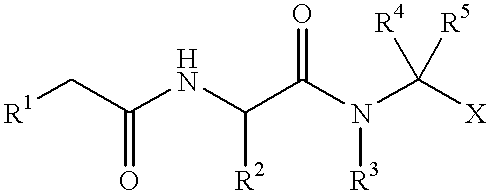Methods and compounds for inhibiting beta-amyloid peptide release and/or its synthesis
a beta-amyloid and peptide technology, applied in the direction of peptide/protein ingredients, applications, drug compositions, etc., can solve the problems of presenting a major present and future public health problem, no treatment that effectively prevents ad or reverses its symptoms and course, and achieves the effect of inhibiting further deterioration in the condition of patients and preventing ad
- Summary
- Abstract
- Description
- Claims
- Application Information
AI Technical Summary
Benefits of technology
Problems solved by technology
Method used
Image
Examples
formulation example 2
[0595] A tablet formula is prepared using the ingredients below:
4 Quantity Ingredient (mg / tablet) Active Ingredient 25.0 Cellulose, microcrystalline 200.0 Colloidal silicon dioxide 10.0 Stearic acid 5.0
[0596] The components are blended and compressed to form tablets, each weighing 240 mg.
formulation example 3
[0597] A dry powder inhaler formulation is prepared containing the following components:
5 Ingredient Weight % Active Ingredient 5 Lactose 95
[0598] The active ingredient is mixed with the lactose and the mixture is added to a dry powder inhaling appliance.
formulation example 4
[0599] Tablets, each containing 30 mg of active ingredient, are prepared as follows:
6 Quantity Ingredient (mg / tablet) Active Ingredient 30.0 mg Starch 45.0 mg Microcrystalline cellulose 35.0 mg Polyvinylpyrrolidone 4.0 mg (as 10% solution in sterile water) Sodium carboxymethyl starch 4.5 mg Magnesium stearate 0.5 mg Talc 1.0 mg Total 120 mg
[0600] The active ingredient, starch and cellulose are passed through a No. 20 mesh U.S. sieve and mixed thoroughly. The solution of polyvinyl-pyrrolidone is mixed with the resultant powders, which are then passed through a 16 mesh U.S. sieve. The granules so produced are dried at 50.degree. to 60.degree. C. and passed through a 16 mesh U.S. sieve. The sodium carboxymethyl starch, magnesium stearate, and talc, previously passed through a No. 30 mesh U.S. sieve, are then added to the granules which, after mixing, are compressed on a tablet machine to yield tablets each weighing 150 mg.
PUM
| Property | Measurement | Unit |
|---|---|---|
| temperature | aaaaa | aaaaa |
| weight percent | aaaaa | aaaaa |
| weight percent | aaaaa | aaaaa |
Abstract
Description
Claims
Application Information
 Login to View More
Login to View More - R&D
- Intellectual Property
- Life Sciences
- Materials
- Tech Scout
- Unparalleled Data Quality
- Higher Quality Content
- 60% Fewer Hallucinations
Browse by: Latest US Patents, China's latest patents, Technical Efficacy Thesaurus, Application Domain, Technology Topic, Popular Technical Reports.
© 2025 PatSnap. All rights reserved.Legal|Privacy policy|Modern Slavery Act Transparency Statement|Sitemap|About US| Contact US: help@patsnap.com



